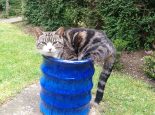Warm weather hazards for pets

Spring and summer are the times of year when we think about getting out the gardening gloves and making the most of our outdoor space. Although it is wonderful to see a garden full of colourful flowers, it is worth bearing in mind that some plants and their bulbs are toxic to pets. Here are some hazards to look out for...
Tulips and hyacinths
All parts of the tulip contain allergenic lactones while hyacinths contain a similar alkaloid, although the bulb is more poisonous than the leaves or petals. Chewing the plant or bulb can result in tissue irritation to the mouth and oesophagus. Typical signs include drooling, vomiting or diarrhoea, depending on the amount consumed. With large ingestions of the bulb, more severe symptoms such as an increase in heart rate and changes in respiration can be seen.
Daffodils
These flowers contain lycorine, an alkaloid which can trigger vomiting. All parts of the plant are toxic and if ingested can cause severe vomiting, diarrhoea, abdominal pain, and even breathing problems. Crystals are found in the outer layer of the bulbs, similar to hyacinths, which cause severe tissue irritation and drooling.
Lilies
Some lilies such as the Peace, Peruvian, and Calla lilies contain oxalate crystals that can cause minor irritation to the mouth, tongue and oesophagus, resulting in minor drooling. Some lilies such as the Tiger, Day, Asiatic, Easter and Japanese Show lilies can be potentially fatal if ingested and are highly toxic to cats! Even small ingestions (such as two to three petals or leaves) can result in severe kidney failure. If your cat is seen consuming any part of a lily, bring your cat (and the plant) immediately to us for medical care.
Crocus
There are two types of Crocus plants: The spring plants are more common and are part of the Iridaceae family. These ingestions can cause general gastrointestinal upset including vomiting and diarrhoea. The Autumn Crocus, part of the Liliaceae family, contain colchicine and is highly toxic – symptoms can include severe vomiting, gastrointestinal bleeding, liver and kidney damage, and respiratory failure. Signs that your pet has ingested the crocus may be seen immediately but can be delayed for several days, so if you have seen your pet ingest the plant, please get them checked out.
Lily of the valley
Ingestion of this plant can cause symptoms which include vomiting, diarrhoea, a drop in heart rate, severe cardiac arrhythmias, and possibly seizures. Pets with any known exposure to this plant should be examined by a vet as soon as possible.
Fertilisers and pesticides
Keen gardeners and pet owners should also be cautious when using fertilisers and plant treatments in the garden. While most are not very toxic (resulting in minor gastrointestinal irritation when consumed), some can be fatal without treatment. Substances that you should be aware of include: blood meal, bone meal, rose and plant fertilizers, pesticides/insecticides and slug and snail pellets.
Chocolate
Chocolate contains Theobromine, a chemical which is toxic to dogs. The darker the chocolate the higher the risk. A small amount of dark chocolate can cause agitation, hyperexcitability, tremors, convulsions and heart disturbances. If your dog eats chocolates it is important to note the amount and type of chocolate eaten to that we can calculate the risk of toxicity.
Grapes, raisins, currants and sultanas
It is not yet known what toxic mechanism causes this reaction and the problem seems to vary. Some dogs have consumed large amounts and had no side effect and other have consumed minimal quantities and gone into kidney failure. Ingestion from cooked fruits (e.g. scones, hot-cross buns, Christmas cake etc) can also cause kidney failure.
Adders
The only venomous snake native in the UK is the European Adder with with the majority of bites occurring in the spring and summer months. Adder bites can be very dangerous especially if the animal is caught on the face. If an animal gets bitten it can cause severe swelling, distress and sometimes bleeding; other complications occur irregularly.
Summer cleaning
Be sure to keep your cleaning products out of reach! Benzalkonium Chloride is a type of detergent found in commonly used household products including disinfectants, antiseptics and some patio cleaners. If the surface is licked, cats can develop drooling, fever and ulcerations to the tongue and mouth. Signs typically take a few hours to develop. The best thing any pet owner can do is keep any potential dangers out of your pet’s reach. If you have any concerns that your pet may have been affected by any of these then please do not hesitate to get in touch with us. The sooner you bring in your pet, the better and more efficiently we can treat the poisoning.
Broadway Veterinary Hospital 158 Broadway, Peterborough E: T: 01733 562904
Image: www.freepik.com/free-vector/nice-dog-playing-in-the-garden-background_871783















